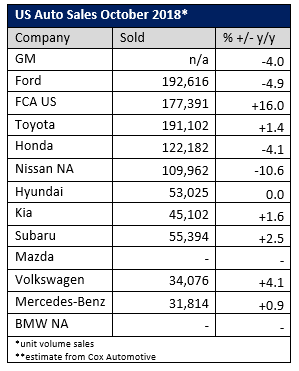Steel Markets

Auto Demand Exceeds Expectations in October
Written by Sandy Williams
November 1, 2018
Robust demand offset increased vehicle pricing and higher interest rates last month, keeping U.S. auto sales strong in October, although weaker than a year ago.
October sales were expected to be impacted by replacement buying due to hurricane damage in the South. There was also one extra selling day in the month.
“Many signs in the economy would suggest that vehicle demand should be moderating – higher interest rates, import tariffs, weak housing market, stock market volatility, elevated gas prices – yet vehicle buying remains strong,” said Charlie Chesbrough, senior economist for Cox Automotive.
FCA turned in the best results for October, with a year-over-year sales gain of 16 percent. Ford sales fell 4.9 percent and General Motors, which no longer reports monthly, is estimated to be down 4.0 percent.
Annualized auto sales are down about 2 percent from a high of 17.55 million in 2016 and are likely to fall further by the end of 2018. The consensus among analysts is that sales will remain above 17 million, however, for the fourth consecutive year.
Affecting affordability are annual loan percentage rates that have climbed to an average of 6.2 percent for new financed vehicles.
“We haven’t seen interest rates hit the 6 percent mark in nearly 10 years, and zero percent finance loans have been cut down by nearly a third of where they were in 2016,” said Jeremy Acevedo, Edmunds’ manager of industry analysis. “It’s getting harder and harder for shoppers to afford a new car, and if the economy starts to slip, we’re at a point now where we really could start to see some significant impacts in the auto market.”

Sandy Williams
Read more from Sandy WilliamsLatest in Steel Markets

CMC looks beyond Arizona micro-mill woes to long-term viability of construction mart
Despite the economic and geopolitical upheaval of the last five years, CMC President and CEO Peter Matt points out that the construction market has been an essential element of the way forward.

US importers face stricter rules under revamped S232 tariffs
“CBP expects full compliance from the trade community for accurate reporting and payment of the additional duties. CBP will take enforcement action on non-compliance," the agency said in a March 7 bulletin.

Steel exports rebound in January
US steel exports recovered to a five-month high in January after having fallen to a two-year low in December. This growth follows four consecutive months of declining exports.

Construction spending drops marginally in January
Construction spending edged down slightly in January, slipping for the first time in four months. The US Census Bureau estimated spending at a seasonally adjusted annual rate of $2,196 billion in January, down 0.2% from December’s downward revised rate. The January figure is 3.3% higher than a year ago. January’s result, despite the slight erosion, […]

HVAC equipment shipments slow in December but strong annually
Shipments of heating and cooling equipment in the US fell to an 11-month low in December, according to the latest data released by the Air-Conditioning, Heating, and Refrigeration Institute (AHRI).

